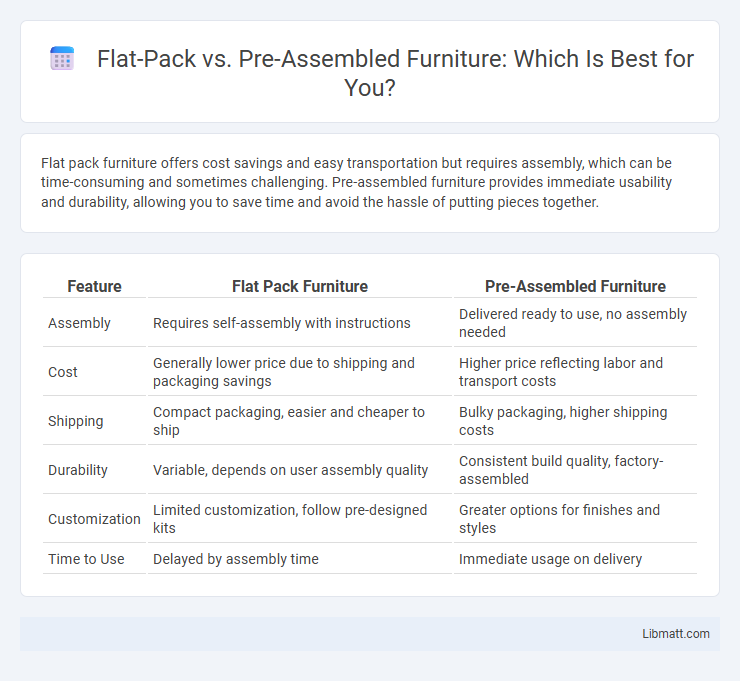Flat pack furniture offers cost savings and easy transportation but requires assembly, which can be time-consuming and sometimes challenging. Pre-assembled furniture provides immediate usability and durability, allowing you to save time and avoid the hassle of putting pieces together.
Table of Comparison
| Feature | Flat Pack Furniture | Pre-Assembled Furniture |
|---|---|---|
| Assembly | Requires self-assembly with instructions | Delivered ready to use, no assembly needed |
| Cost | Generally lower price due to shipping and packaging savings | Higher price reflecting labor and transport costs |
| Shipping | Compact packaging, easier and cheaper to ship | Bulky packaging, higher shipping costs |
| Durability | Variable, depends on user assembly quality | Consistent build quality, factory-assembled |
| Customization | Limited customization, follow pre-designed kits | Greater options for finishes and styles |
| Time to Use | Delayed by assembly time | Immediate usage on delivery |
Introduction to Flat Pack and Pre-Assembled Furniture
Flat pack furniture consists of unassembled components shipped in compact boxes, designed for easy transportation and DIY assembly at home, making it a popular choice for budget-conscious consumers and space-saving solutions. Pre-assembled furniture arrives fully constructed, offering immediate usability and often featuring higher durability and finish quality, suitable for those prioritizing convenience and time-saving. Understanding the distinctions in packaging, assembly process, and user experience helps consumers select between flat pack and pre-assembled furniture based on their individual needs and preferences.
Key Differences Between Flat Pack and Pre-Assembled
Flat pack furniture arrives in compact, disassembled pieces requiring self-assembly, which saves on shipping costs and allows customization in placement. Pre-assembled furniture is delivered fully constructed, offering immediate usability and durability without the need for tools or instructions. Your choice depends on convenience preferences, budget considerations, and the desired speed of setup.
Cost Comparison: Which is More Budget-Friendly?
Flat pack furniture generally offers a more budget-friendly option due to lower manufacturing and shipping costs, making it ideal for consumers looking to save. Pre-assembled furniture typically incurs higher expenses from labor and packaging, reflecting in the retail price. Your choice depends on balancing upfront cost savings with convenience and time investment in assembly.
Assembly Time and Effort Required
Flat pack furniture typically requires more assembly time and effort, as it arrives in separate parts that need to be carefully constructed, often involving tools and detailed instructions. Pre-assembled furniture significantly reduces your workload, arriving ready to use with minimal setup, saving hours and avoiding the frustration of complex assembly. Choosing between the two depends on your availability and willingness to invest time in putting furniture together.
Durability and Build Quality
Flat pack furniture offers customizable assembly, allowing you to ensure tight connections and secure fittings, but it often relies on engineered wood or particleboard, which may compromise long-term durability compared to solid wood options. Pre-assembled furniture typically features factory-assembled joints and higher-grade materials, ensuring consistent build quality and structural integrity that can withstand daily wear and tear more effectively. Choosing based on your priorities for ease of setup versus long-lasting sturdiness can impact the overall lifespan and performance of your furniture investment.
Delivery and Transportation Considerations
Flat pack furniture offers significant advantages in delivery and transportation due to its compact packaging, allowing for easier handling, lower shipping costs, and reduced storage space requirements. Pre-assembled units often require larger vehicles and careful maneuvering to prevent damage, increasing the risk and expense of transportation. Choosing flat pack options can streamline logistics, enhancing efficiency for both retailers and consumers.
Customization and Design Flexibility
Flat pack furniture offers greater customization and design flexibility, allowing you to modify components or finishes to match your personal style and space requirements. Pre-assembled furniture typically comes with fixed dimensions and styles, limiting your ability to adapt the design after purchase. Choosing flat pack solutions empowers you to create a unique, tailored setup that evolves with your tastes and needs.
Environmental Impact and Sustainability
Flat pack furniture significantly reduces environmental impact through efficient packaging and lower transportation emissions, minimizing carbon footprint compared to pre-assembled options. Pre-assembled furniture often requires bulkier packaging and more storage space, increasing resource consumption and waste. Choosing flat pack furniture supports your commitment to sustainability by promoting reduced material use and enhanced recyclability.
Ideal Use Cases for Each Option
Flat pack furniture is ideal for those who value cost-efficiency, easy transportation, and enjoy the process of DIY assembly, making it perfect for renters, students, or individuals frequently relocating. Pre-assembled furniture suits buyers seeking convenience, immediate use, and high-quality craftsmanship, often preferred in permanent homes or professional office settings. Your choice depends on balancing budget, time constraints, and personal preference for hands-on assembly versus ready-to-use functionality.
Conclusion: Choosing the Right Furniture Type
Selecting between flat pack and pre-assembled furniture depends on factors such as budget, convenience, and customization needs. Flat pack furniture offers cost savings and easy transportation but requires time and skill for assembly, while pre-assembled options provide immediate usability and higher durability at a premium price. Evaluating lifestyle preferences and space constraints ensures the right furniture choice aligns perfectly with individual needs.
Flat Pack vs Pre-Assembled Infographic

 libmatt.com
libmatt.com